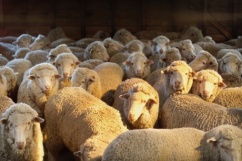 hworth, QMS head of economics services, said that exchange rates were a big issue for lamb prices: “The challenge for the UK is that with one euro currently buying about 80p compared to around 86p a year ago, the euro price for UK lamb is, like Ireland, France and Spain, little changed on the year, but the sterling price is much lower.”
hworth, QMS head of economics services, said that exchange rates were a big issue for lamb prices: “The challenge for the UK is that with one euro currently buying about 80p compared to around 86p a year ago, the euro price for UK lamb is, like Ireland, France and Spain, little changed on the year, but the sterling price is much lower.”Furthermore, since the beginning of June, English and Welsh auctions have handled 20% more lambs than last year, and Scottish auctions have handled around 50% more. QMS said a similar pattern had emerged in the Republic of Ireland where abattoir throughputs of lamb are up by around 20%.
Ashworth said there was an increased lamb crop in 2014: “By comparing the number of lambs reaching abattoirs during June with historic precedent, we can begin to develop a view on the size of the 2014 lamb crop, for example between 5-6% of the lamb crop typically reaches the market in June.
“On the basis of this proportion of the lamb crop sold by the end of June, there will be a significant increase in the 2014 lamb crop. Comparing that information with December data on breeding sheep numbers helps to refine expectation.”
QMS believes the GB lamb crop could be up 7% on last year, due to higher breeding sheep numbers, in England in particular. However, Ashworth added: “This does not necessarily mean that the wider marketplace will be over-supplied with lamb. Even if these extra lambs reached the market, it would still leave the annual total well below the levels seen only four years ago.”
QMS also said that consumer confidence was a major contributor to market returns. “In this respect, the latest consumer confidence indicators for the UK are at their highest level since 2005.”





